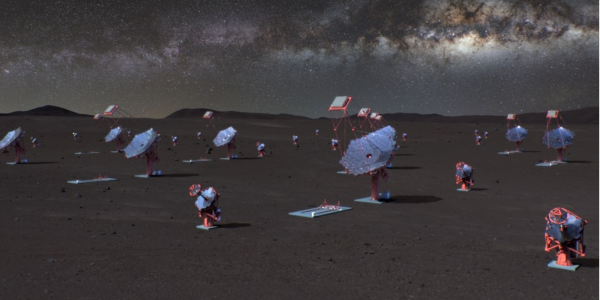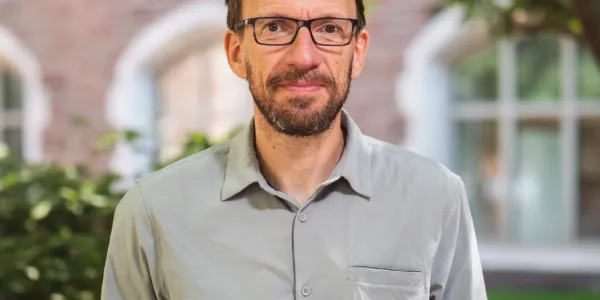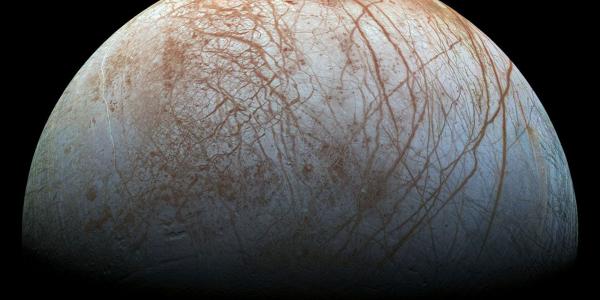Manel Errando will lead a team of WashU researchers and engineers on a project with international — and cosmic — reach.

A team of WashU researchers and engineers has been awarded a $3.9 million grant from the National Science Foundation (NSF) to build and install gamma-ray cameras for the Small-Sized Telescopes of the Cherenkov Telescope Array Observatory (CTAO), the smallest of the three classes of telescopes the observatory will deploy. The SSTs are planned for the CTAO’s Southern Hemisphere site, CTAO-South, in Paranal, Chile.
“When the cameras are installed in 2028, the observatory will be the largest and most sensitive high-energy observatory for gamma-ray astronomy in the world,” said Manel Errando, an associate professor of physics who is leading the WashU team. “This is an exciting opportunity to continue the long tradition of gamma-ray research at WashU,” said Errando, who is also a fellow of the McDonnell Center for the Space Sciences.
The WashU team will contribute the light sensors for 10 cameras of the SSTs as well as the readout and control electronics to operate them. The cameras’ high-speed electronics, designed to record images at a rate of one billion per second, will be able to detect gamma rays from cosmic sources such as pulsars, clusters of young stars, the Milky Way’s central black hole, and fast jets from giant growing black holes in other galaxies.
The team includes James H. Buckley, a professor of physics; Richard Bose, a senior research engineer in the Department of Physics; and several other WashU engineers and students. Justin Vandenbroucke, a professor at the University of Wisconsin–Madison, is a co-principal investigator.
The participation of researchers from WashU and the University of Wisconsin–Madison is significant because it will give astronomers and physicists across the United States a chance to benefit from CTAO discoveries. The funding allows the United States to formally apply for third-party membership within CTAO governance, giving U.S. researchers access to data collected from both observation stations in Chile and the Canary Islands. “We’re proud to help open up this incredible facility to researchers at U.S. institutions,” Errando said.

U.S. researchers have been deeply involved in the CTAO project since its inception more than a decade ago, contributing across governance, scientific and technological domains. “The U.S. teams have been an important supporter of the CTAO throughout its history,” said Stuart McMuldroch, CTAO director general. “We are grateful for their contributions and look forward to continuing and expanding our work together in this new phase.”
Errando is especially interested in gaining unprecedented views of phenomena at the center of the galaxy. “Because of the tilt of the Earth in relation to the plane of the Milky Way, observatories in the Southern Hemisphere have a more direct view into the very center of the galaxy,” he said.
The new observations should help clarify the source of high-energy cosmic rays that send particles hurtling throughout the galaxy at tremendous speeds. One theory suggests the rays are generated by shock waves from supernova explosions, some of the most cataclysmic events in the galaxy. “There’s about one supernova explosion in our galaxy every 100 years,” Errando said. “The CTAO should help us see the aftermath of such events in great detail.”
WashU has a long history of providing technical expertise to gamma-ray observatories. Buckley played an instrumental role in the planning and construction of the VERITAS telescopes in Arizona. VERITAS is currently one of the largest gamma-ray instrument arrays of its type, but it will be surpassed by the CTAO.
“The new observatory will greatly expand our vision,” Errando said. “Ultimately, we’ll have a clearer view of the formation of new stars and the evolution of the galaxy.”
Header image: Artist’s conception of the Cherenkov Telescope Array Observatory in Paranal, Chile. (Credit: CTAO)





